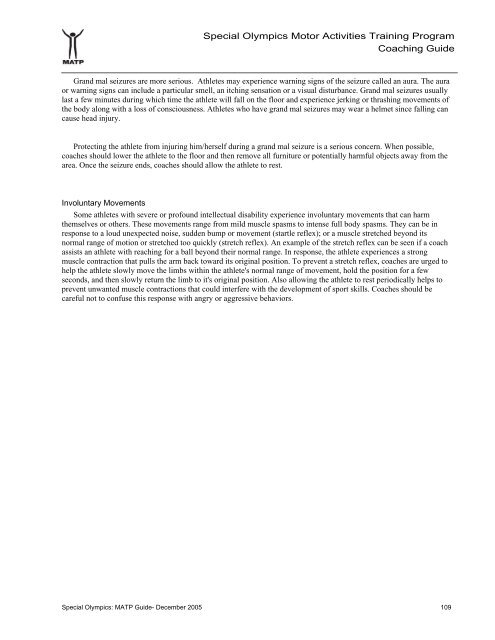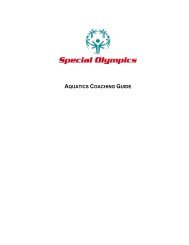MATP Coaching Guide - Special Olympics
MATP Coaching Guide - Special Olympics
MATP Coaching Guide - Special Olympics
You also want an ePaper? Increase the reach of your titles
YUMPU automatically turns print PDFs into web optimized ePapers that Google loves.
<strong>Special</strong> <strong>Olympics</strong> Motor Activities Training Program<br />
<strong>Coaching</strong> <strong>Guide</strong><br />
Grand mal seizures are more serious. Athletes may experience warning signs of the seizure called an aura. The aura<br />
or warning signs can include a particular smell, an itching sensation or a visual disturbance. Grand mal seizures usually<br />
last a few minutes during which time the athlete will fall on the floor and experience jerking or thrashing movements of<br />
the body along with a loss of consciousness. Athletes who have grand mal seizures may wear a helmet since falling can<br />
cause head injury.<br />
Protecting the athlete from injuring him/herself during a grand mal seizure is a serious concern. When possible,<br />
coaches should lower the athlete to the floor and then remove all furniture or potentially harmful objects away from the<br />
area. Once the seizure ends, coaches should allow the athlete to rest.<br />
Involuntary Movements<br />
Some athletes with severe or profound intellectual disability experience involuntary movements that can harm<br />
themselves or others. These movements range from mild muscle spasms to intense full body spasms. They can be in<br />
response to a loud unexpected noise, sudden bump or movement (startle reflex); or a muscle stretched beyond its<br />
normal range of motion or stretched too quickly (stretch reflex). An example of the stretch reflex can be seen if a coach<br />
assists an athlete with reaching for a ball beyond their normal range. In response, the athlete experiences a strong<br />
muscle contraction that pulls the arm back toward its original position. To prevent a stretch reflex, coaches are urged to<br />
help the athlete slowly move the limbs within the athlete's normal range of movement, hold the position for a few<br />
seconds, and then slowly return the limb to it's original position. Also allowing the athlete to rest periodically helps to<br />
prevent unwanted muscle contractions that could interfere with the development of sport skills. Coaches should be<br />
careful not to confuse this response with angry or aggressive behaviors.<br />
<strong>Special</strong> <strong>Olympics</strong>: <strong>MATP</strong> <strong>Guide</strong>- December 2005 109
















